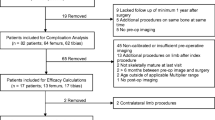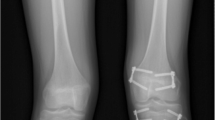Abstract
Objectives
The best effective treatment strategy for limb length discrepancy (LLD) is still being debated. The goal of this study was to compare the efficacy and results of tension-band plating (TBP) and percutaneous epiphysiodesis using transphyseal screws (PETS) for LLD correction.
Methods
From June 2008 to January 2019, children who had lower extremity epiphysiodesis with either TBP or PETS were reviewed retrospectively. At the conclusion of treatment, LLD, angular deformity, and complications were reviewed. The t-test or Wilcoxon rank sum test was used to compare continuous variables. Categorical variables were evaluated using Fisher’s exact test or χ2 test.
Results
A total of 32 epiphysiodeses with TBP (14 patients, 24 femur/tibias) or PETS (13 patients, 23 femur/tibias) were compared. TBPs were conducted while the patients were younger (11.0 vs. 13.1 years, p = 0.005). The treatment durations were similar in both groups (TBP: 23.5 months vs. PETS: 24 months, p = 0.132). PETS had significantly shorter operative time (p = 0.047), length of hospital stay (p = 0.014), and time to return to full activity (p = 0.043). LLD in the TBP group reduced from 2.64 to 1.38 cm (p = 0.005), while in the PETS group it decreased from 2.76 to 1.08 cm (p = 0.001). During treatment, the rate of LLD correction was 0.49 ± 0.9 cm/year for limbs treated with TBP and 1.0 ± 1.1 cm/year for limbs treated with PETS (p = 0.185). At the end of treatment, 8 TBP cases (47%) and 9 PETS cases (60%) had achieved LLD ≤ 2 cm (p = 0.502), and at the most recent follow-up, this had grown to 11 (65%) in the TBP group and 12 (80%) in the PETS group. There were no significant differences in the total number of complications between groups (p > 0.05). Revision surgery was required in 11 TBP and 3 PETS limbs due to persistent LLD or angular deformity (AD) (p = 0.016). Logistic regression did not reveal any significant association between TBP and the rate of complication or revision surgery.
Conclusion
PETS and TBP are both effective methods for limb length equalization. PETS, on the other hand, was linked to a shorter operative time, a shorter hospital stay, a faster recovery to pre-operative function, and a lower complication rate. The rate of revision surgery due to persistent LLD or AD was higher in TBP. We advise surgeons against utilizing TBP to correct LLD.
Level of evidence
III.




Similar content being viewed by others
References
Ruzbarsky JJ, Goodbody C, Dodwell E (2017) Closing the growth plate: a review of indications and surgical options. Curr Opin Pediatr 29(1):80–86
Stevens PM (2016) The role of guided growth as it relates to limb lengthening. J Child Orthop 10(6):479–486
Vitale MA, Choe JC, Sesko AM, Hyman JE, Lee FY, Roye DP Jr et al (2006) The effect of limb length discrepancy on health-related quality of life: Is the ‘2 cm rule’ appropriate? J Pediatr Orthop B 15(1):1–5
Metaizeau JP, Wong-Chung J, Bertrand H, Pasquier P (1998) Percutaneous epiphysiodesis using transphyseal screws (PETS). J Pediatr Orthop 18(3):363–369
Stevens PM (2007) Guided growth for angular correction: a preliminary series using a tension band plate. J Pediatr Orthop 27(3):253–259
Lykissas MG, Jain VV, Manickam V, Nathan S, Eismann EA, McCarthy JJ (2013) Guided growth for the treatment of limb length discrepancy: a comparative study of the three most commonly used surgical techniques. J Pediatr Orthop B 22(4):311–317
Paley D, Herzenberg JE, Tetsworth K, McKie J, Bhave A (1994) Deformity planning for frontal and sagittal plane corrective osteotomies. Orthop Clin North Am 25(3):425–465
Song MH, Choi ES, Park MS, Yoo WJ, Chung CY, Choi IH et al (2015) Percutaneous epiphysiodesis using transphyseal screws in the management of leg length discrepancy: optimal operation timing and techniques to avoid complications. J Pediatr Orthop 35(1):89–93
Paley D, Bhave A, Herzenberg JE, Bowen JR (2000) Multiplier method for predicting limb-length discrepancy. J Bone Joint Surg Am 82(10):1432–1446
Troy M, Shore B, Miller P, Mahan S, Hedequist D, Heyworth B et al (2018) A comparison of screw versus drill and curettage epiphysiodesis to correct leg-length discrepancy. J Child Orthop 12(5):509–514
Stewart D, Cheema A, Szalay EA (2013) Dual 8-plate technique is not as effective as ablation for epiphysiodesis about the knee. J Pediatr Orthop 33(8):843–846
Lauge-Pedersen H, Hagglund G (2013) Eight plate should not be used for treating leg length discrepancy. J Child Orthop 7(4):285–288
Gaumetou E, Mallet C, Souchet P, Mazda K, Ilharreborde B (2016) Poor efficiency of eight-plates in the treatment of lower limb discrepancy. J Pediatr Orthop 36(7):715–719
Bayhan IA, Karatas AF, Rogers KJ, Bowen JR, Thacker MM (2017) Comparing percutaneous physeal epiphysiodesis and eight-plate epiphysiodesis for the treatment of limb length discrepancy. J Pediatr Orthop 37(5):323–327
Ilharreborde B, Gaumetou E, Souchet P, Fitoussi F, Presedo A, Pennecot GF et al (2012) Efficacy and late complications of percutaneous epiphysiodesis with transphyseal screws. J Bone Joint Surg Br 94(2):270–275
Campens C, Mousny M, Docquier PL (2010) Comparison of three surgical epiphysiodesis techniques for the treatment of lower limb length discrepancy. Acta Orthop Belg 76(2):226–232
Nouth F, Kuo LA (2004) Percutaneous epiphysiodesis using transphyseal screws (PETS): prospective case study and review. J Pediatr Orthop 24(6):721–725
Pendleton AM, Stevens PM, Hung M (2013) Guided growth for the treatment of moderate leg-length discrepancy. Orthopedics 36(5):e575–e580
Siedhoff M, Ridderbusch K, Breyer S, Stucker R, Rupprecht M (2014) Temporary epiphyseodesis for limb-length discrepancy. 8- to 15-year follow-up of 34 children. Acta Orthop 85(6):626–632
Funding
No funding was received.
Author information
Authors and Affiliations
Contributions
MY, Design; Data acquisition; analysis; Interpretation of data; Drafting and critical revision; Final approval of submission. RH, Design; Data acquisition; analysis; Interpretation of data; Drafting and critical revision; Final approval of submission. KJ, Data acquisition; Drafting and critical revision; Final approval of submission. EF, Interpretation of data; Drafting and critical revision; Final approval of submission. JG, Interpretation of data; Drafting and critical revision; Final approval of submission. MS, Interpretation of data; Drafting and critical revision; Final approval of submission. JS, Design; Interpretation of data; Drafting and critical revision; Final approval of submission.
Corresponding author
Ethics declarations
Conflict of interest
MHY, RH, KJ, EDF, MSS and JFS declare that they have no conflict of interest. JAG reports a consultancy and honoraria with Stryker Spine outside the submitted work.
Ethical approval
All procedures performed in studies involving human participants were in accordance with the ethical standards of the institutional and/or national research committee and with the 1964 Helsinki declaration and its later amendments or comparable ethical standards.
Informed consent
Not applicable.
Additional information
Publisher's Note
Springer Nature remains neutral with regard to jurisdictional claims in published maps and institutional affiliations.
Rights and permissions
About this article
Cite this article
Younis, M.H., Hanstein, R., Javed, K. et al. Percutaneous epiphysiodesis using transphyseal screws (PETS) versus tension-band plating (TBP): comparative study of outcomes for correcting limb length discrepancy. Eur J Orthop Surg Traumatol 33, 1523–1531 (2023). https://doi.org/10.1007/s00590-022-03304-0
Received:
Accepted:
Published:
Issue Date:
DOI: https://doi.org/10.1007/s00590-022-03304-0




